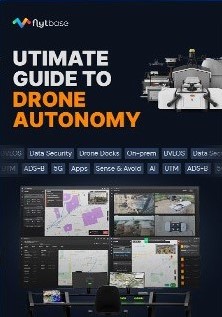Get Your Free Drone Autonomy Guide Today!

The need for security and surveillance - whether residential or commercial - continues to steadily increase in a world of increasing volatility, uncertainty, complexity, and ambiguity. Privacy, not just security is becoming as much of a concern - with technology playing a central role on both fronts i.e. in violation of privacy and in the provision of security. This is where drones for security come in, powered by reliable hardware and intelligent software.

Traditional security systems (human guards, CCTV cameras, locks, access control systems, etc.) continue to prevail amongst security and surveillance providers. However, new technologies ranging from drones and robots to biometrics, AI and cyber-security have started to capture a larger share of the market.
These technologies offer a range of benefits - automation, scalability, remote management, auditability, cost-effectiveness, reliability, mass customization and so on.
Benefit of Using Drones for Home Security
Unmanned aerial vehicles (i.e. drones) are already part of the most advanced home and office security systems, with a fleet of drones programmed to launch from their nests, run repeated missions, capture aerial footage of the assets being secured, and return to their nests to charge and prepare for the next mission.
By augmenting, if not replacing, human guards and static CCTVs, these ‘eyes in the sky’ can offer faster response to incidents, real-time situational awareness to the central command, live video feeds to remote stakeholders, and even serve as a deterrence to unfriendly elements.
{{pdf-form}}
Demand for Drones in Security & Surveillance Applications
While regulation remains a challenge for outdoor operations such as aerial security and surveillance using drones, technology has advanced enough to enable drone-in-a-box security systems. These include not just drones, but also autonomous charging pads, weather-proof docking stations, intelligent automation via software, cloud connectivity and live remote operations.
The key to large-scale adoption of such drone surveillance systems is their cost-effectiveness; which in turn requires the use of off-the-shelf drone hardware and SaaS-enabled solutions that minimize the upfront capital expenditure.
Importance of Autonomous Drones for Residential & Commercial Security
Residential security drones have made the news in recent years, but it is industrial and commercial security systems that are seeing faster adoption. This is driven not only by enterprise initiatives in security automation but also by the rapidly increasing costs of human guards for drone security system providers, made worse by constant employee turnover.

By putting equipment, instead of humans, at risk of harm in case of adverse incidents, aerial surveillance drones minimize risk and enable better-informed decisions during security events.
The best surveillance drones can, in fact, be rapidly sent to a location of interest, using GPS navigation and 4G/5G connectivity, to immediately stream live video feeds and even carry payloads such as sirens or warning lights. With thermal and IR cameras easily available, night-time drone patrols and alarms can be an integral part of aerial home/office surveillance systems.
How Autonomous Drone Security System Works?

Autonomy is - of course - the key to drones for security, since having human operators involved in UAV surveillance can not only add to the cost, but also introduce the risk of errors, or worse, loss of integrity of security operations. Software-driven automation of drones is thus driving their adoption for home security as well as industrial perimeter security.
By defining specific points of interest, ideal schedules, and waypoint-wise camera action, such autonomous UAV security systems can be programmed to operate reliably and continuously and can be rapidly deployed across large swathes of residential or commercial areas. Automatic obstacle detection, collision avoidance and precision landing capabilities further expand the use-cases for drones in this context.
The Role of AI/ML in Making Drones Smarter
By incorporating AI/ML techniques, image processing, and machine vision, drone security systems can even recognize things, track-and-follow intruders, and automatically identify objects that post threats.
The physical size and weight of drones are reducing rapidly as the technology matures; such drones can make hard-to-reach locations easily accessible - and make harsh environments more secure - without putting humans at risk of harm.

Aerial video surveillance is thus turning out to be the next frontier for the security industry, powered by autonomous drone fleets that are intelligent, cloud-connected and remotely managed.
How can drones be easily adopted for security use cases?
FlytBase presents an opportunity for users to explore the vast capabilities of autonomous drone operations. With a focus on security stakeholders, customers can seamlessly integrate their drone fleets, enabling autonomous flight, customized mission coordination, geo-fencing, and checklist implementation. Real-time video streaming and storage empower users with valuable insights for informed decision-making.
FlytBase's integration capabilities ensure a unified drone operations ecosystem that seamlessly fits into existing systems. This immersive experience allows security stakeholders to leverage the power of autonomous drones and revolutionize their approach to security management. Discover the immense potential and elevate security operations with FlytBase's comprehensive solutions.
Schedule a demo now and take the first step towards transforming your security operations.
FAQs
Find quick answers to common questions about compatibility, setup, features, and pricing
.jpg)


.webp)
.svg)
.webp)



